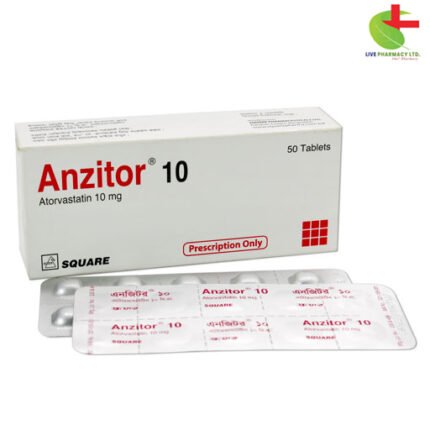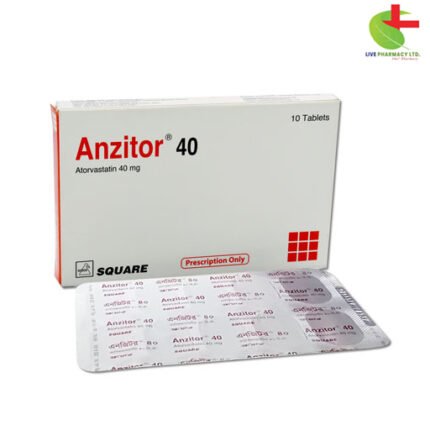Anzitor 20
200.00৳ Strip
- Anzitor contains atorvastatin and is used alongside diet to manage elevated cholesterol and triglyceride levels.
- It is indicated for conditions like familial hypercholesterolemia and dyslipidemia.
- Anzitor selectively inhibits HMG-CoA reductase, effectively reducing plasma cholesterol and lipoprotein levels.
- Common side effects include constipation, flatulence, and dyspepsia.
- Patients with liver disease should use Anzitor cautiously, with regular monitoring during treatment.
 Brand
Brand
|
Square Pharmaceuticals PLC |
|---|---|
 Generics
Generics
|
Atorvastatin Calcium |
Indications
Anzitor serves as a complementary measure alongside dietary adjustments to alleviate elevated levels of total cholesterol, LDL cholesterol, apolipoprotein B (Apo-B), and triglycerides in the following conditions when dietary changes and non-pharmacological interventions prove insufficient:
- Lowering total and LDL cholesterol in patients with heterozygous and homozygous familial hypercholesterolemia.
- Managing elevated cholesterol and triglyceride levels in patients with mixed dyslipidemia (Fredrickson Type Ia and Ib).
- Treating patients with elevated serum triglyceride levels in hypertriglyceridemia (Fredrickson Type IV).
- Addressing dysbetalipoproteinemia (Fredrickson Type III).
- Reducing cardiac ischemic events in patients with asymptomatic or mildly to moderately symptomatic coronary artery disease with elevated LDL-cholesterol level.
- Managing total and LDL-cholesterol concentrations in patients with hypercholesterolemia associated with or exacerbated by diabetes mellitus or renal transplantation.
Pharmacology
Atorvastatin functions as a selective inhibitor of HMG-CoA reductase, the pivotal enzyme in converting HMG-CoA to mevalonate, a precursor of sterols like cholesterol. By inhibiting HMG-CoA reductase, atorvastatin lowers plasma cholesterol and lipoprotein levels, promoting the uptake and breakdown of LDL through increased hepatic LDL receptors.
Absorption
Following oral administration, atorvastatin is rapidly absorbed, with peak plasma concentrations attained within 1 to 2 hours. Absorption increases proportionally with dosage, with approximately 14% absolute bioavailability for atorvastatin and around 30% systemic availability of HMG-CoA reductase inhibitory activity.
Distribution
Atorvastatin exhibits a mean volume of distribution of approximately 381 liters and is highly bound to plasma proteins (98%). Minimal penetration into red blood cells is indicated by a blood/plasma ratio of approximately 0.25. Potential secretion into human milk is suggested based on rat studies.
Metabolism
Extensive metabolism of atorvastatin occurs, yielding ortho- and parahydroxylated derivatives and various beta-oxidation products. Active metabolites contribute to approximately 70% of circulating inhibitory activity for HMG-CoA reductase. Cytochrome P450 3A4 is involved in atorvastatin metabolism, with potential interactions observed with inhibitors such as erythromycin.
Excretion
Primarily eliminated in bile following hepatic and/or extra-hepatic metabolism, atorvastatin and its metabolites exhibit a mean plasma elimination half-life of approximately 14 hours in humans, with the half-life of inhibitory activity for HMG-CoA reductase extending to 20 to 30 hours due to active metabolites.
Dosage & Administration
For primary hypercholesterolemia and combined hyperlipidemia in adults, the typical initial dose is 10 mg once daily, adjustable at intervals of at least 4 weeks to a maximum of 80 mg once daily. Pediatric dosing varies, with initial dosing at 10 mg once daily for children aged 10-18 years, adjustable to a maximum of 20 mg once daily.
For familial hypercholesterolemia, adult and pediatric dosing recommendations follow similar adjustment protocols, with initial dosing at 10 mg once daily, potentially increased to 40 mg once daily and a maximum of 80 mg once daily for adults.
Another guideline advises starting with a standard cholesterol-lowering diet before initiating atorvastatin treatment, with recommended starting doses of 10 or 20 mg once daily. Dosage adjustments should be made based on lipid level analysis within 2 to 4 weeks of initiation.
Interaction
Concurrent administration of drugs like cyclosporine, fibric acid derivatives, niacin, erythromycin, and azole antifungals heightens the risk of myopathy during atorvastatin treatment.
Absorption of atorvastatin may decrease when coadministered with antacids or colestipol, though LDL-C reduction may not be affected. Digoxin, erythromycin, oral contraceptives, and warfarin interactions with atorvastatin require appropriate monitoring and potential dosage adjustments.
Contraindications
Atorvastatin should be avoided in patients with hypersensitivity to any component of the medication, active liver disease, or unexplained persistent elevations of serum transaminases. It is contraindicated in patients with a history of serious adverse reactions to prior administration of HMG-CoA reductase inhibitors.
Side Effects
Common side effects associated with Anzitor include constipation, flatulence, dyspepsia, and abdominal pain. Infrequent side effects may include infection, headache, back pain, rash, asthenia, arthralgia, and myalgia.
Pregnancy & Lactation
Atorvastatin is contraindicated during pregnancy due to potential fetal harm. Safety in pregnant women has not been established, and caution is advised. While data on excretion into human milk are limited, atorvastatin should not be used during breastfeeding due to potential risks.
Precautions & Warnings
Liver function tests should be performed before initiating atorvastatin treatment and periodically thereafter. Caution is advised in patients with substantial alcohol consumption or a history of liver disease. Anzitor therapy should be discontinued if markedly elevated CPK levels occur or myopathy is diagnosed or suspected.
Use in Special Populations
Elderly patients may exhibit higher plasma concentrations of Anzitor, necessitating caution in dosing. Limited pharmacokinetic data are available for pediatric populations. Gender differences in LDL-C reduction are not clinically significant, and renal disease does not affect plasma concentrations or LDL-C reduction.
Overdose Effects
Specific treatment for atorvastatin overdose is unavailable. Symptomatic and supportive measures should be instituted, with liver function tests and serum CK levels monitored. Hemodialysis is unlikely to significantly enhance atorvastatin clearance due to extensive plasma protein binding.
Therapeutic Class
Anzitor belongs to the class of Other Anti-anginal & Anti-ischemic drugs, Statins.
Storage Conditions
Store Anzitor in a dry place away from light and heat, out of the reach of children.
Chemical Structure
Molecular Formula: C33H35FN2O5, Chemical Structure: [Chemical Structure of Atorvastatin Calcium]
Common Questions about Anzitor 10 mg Tablet
- What is Anzitor 10 mg Tablet?
- How should I take Anzitor 10 mg Tablet?
- What are the uses of Anzitor 10 mg Tablet?
- What are the Side Effects of Anzitor 10 mg Tablet?
- What are the instructions for storage and disposal of Anzitor 10 mg Tablet?
- Is Anzitor 10 mg Tablet used for lowering cholesterol?
- Will taking Anzitor 10 mg Tablet increase my risk of diabetes?
- For how long do I need to take Anzitor 10 mg Tablet? Is it safe for long-term use?
- Does Anzitor 10 mg Tablet cause weight loss?
- Can I stop taking Anzitor 10 mg Tablet?
- Does Anzitor 10 mg Tablet cause memory loss?
- Does Anzitor 10 mg Tablet make you tired?
- Can Anzitor 10 mg Tablet be prescribed to children?
- Is Anzitor 10 mg Tablet a blood thinner?













Reviews
There are no reviews yet.